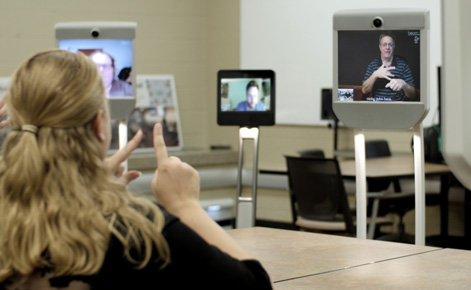
A Sign Language interpreter communicates with a student using the Beam robot technology.
A technology-based, student-focused course in the College of Education has received an Honorable Mention in Michigan State University’s annual Award Competition in Instructional Technology, sponsored by AT&T.
CEP 956: Mind, Media and Learning, taught by Associate Professor Christine Greenhow, is a graduate course in the Educational Psychology and Educational Technology (EPET) doctoral program. Its attention to integrating technology, collaborating with students near and far and its innovative approach to disability support is what makes the class so unique and important.
“Now more than ever, students have more say in how, when and why they learn,” Greenhow said. “Our challenge is to make teaching and learning accessible anytime, anywhere and anyhow. We need to rethink traditional classrooms to support students and instructors of all kinds.”
 The course teaches students to critically explore and evaluate how people learn and teach with new technologies, such as social media, and the reciprocal relationships between educational psychology and educational technology. Students are at the center of the course—and, in many ways, framing how it is taught.
The course teaches students to critically explore and evaluate how people learn and teach with new technologies, such as social media, and the reciprocal relationships between educational psychology and educational technology. Students are at the center of the course—and, in many ways, framing how it is taught.
Greenhow is a “big believer” in co-creating her courses. While she prepares for class with readings and assignments in mind, Greenhow also uses the social media, Twitter, as a backchannel for the course. This allows students to contribute their ideas and resources, in effect, helping to shape the course. Students used the #MSUEPET hashtag to share their questions and comments before, during and after class. The #MSUEPET hashtag connected students to the larger EPET student base that regularly uses the hashtag.
Greenhow also introduced robotic telepresence technologies in the form of Beam robots to connect students from all over the United States. Unlike video-conferencing technology such as Skype or Zoom, the Beam robots give students a physical space in the classroom: They are able to move the robots around the room, turn and adjust the “head and body” of the robot and control other functions, such as zooming in and out.
“With the Beam robot technologies, we can break down the distance students feel,” Greenhow said in a video about the course (see below). “The online students who came in robot form felt that they were seen [and heard] by the instructor and their on-campus peers better when they were in robot form.”
Greenhow and other faculty in the EPET program have used the robots and other similar technology before. In this case, the technology improved the learning experience and provided support for a student with an auditory disability.
The Beam robots have a large screen, zooming capabilities and an ability for the sign language interpreter to see herself signing in a corner of the screen. It provided a mirror as to what the Deaf student was seeing her do, and helped with two-way communication and trouble shooting.
“Online programs are growing and continue to grow. Scholars and instructors must push the envelope to find technology that works best for each individual student—it’s not a one-size-fits-all approach,” Greenhow continued. “More research needs to be done in this area—we’re only at the tip of the iceberg in this research and what is possible.”
William Cain, assistant designer in the CEPSE/COE Design Studio, served as co-designer of the course, providing technology assistance for students and orienting them to the Beam robots. Virginia “Ginger” Martz—blindness/visual impairments, deaf/hard of hearing and mobility specialist for the Resource Center for Persons with Disabilities (RCPD)—also served as the course’s co-designer.




